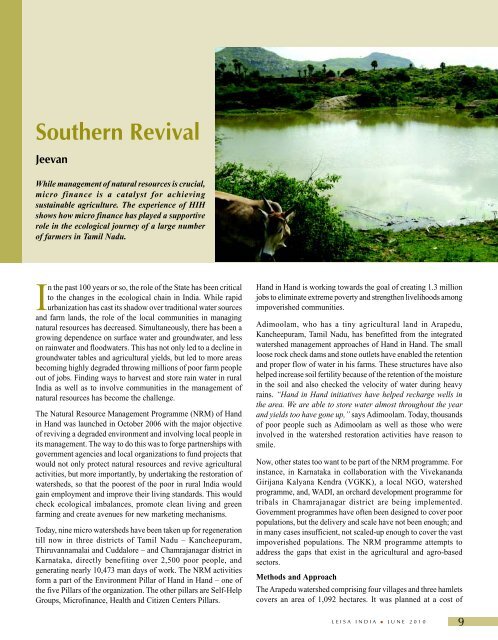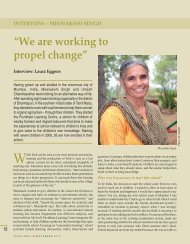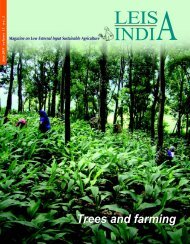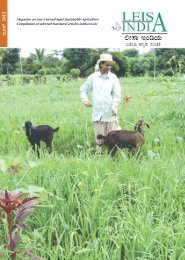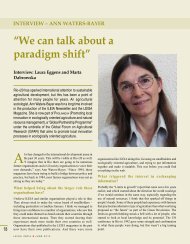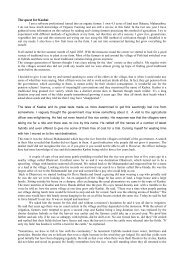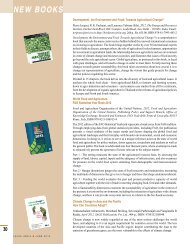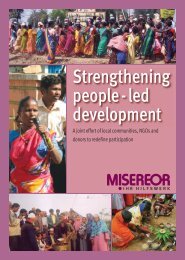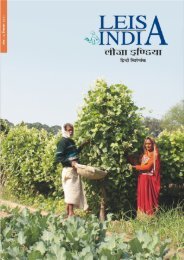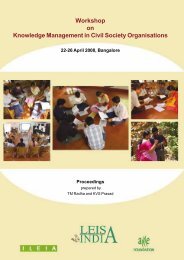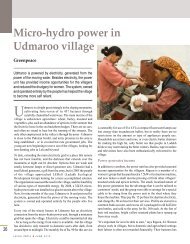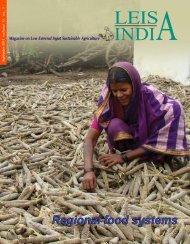INDI LEISA - Leisa India
INDI LEISA - Leisa India
INDI LEISA - Leisa India
You also want an ePaper? Increase the reach of your titles
YUMPU automatically turns print PDFs into web optimized ePapers that Google loves.
Southern RevivalJeevanWhile management of natural resources is crucial,micro finance is a catalyst for achievingsustainable agriculture. The experience of HIHshows how micro finance has played a supportiverole in the ecological journey of a large numberof farmers in Tamil Nadu.In the past 100 years or so, the role of the State has been criticalto the changes in the ecological chain in <strong>India</strong>. While rapidurbanization has cast its shadow over traditional water sourcesand farm lands, the role of the local communities in managingnatural resources has decreased. Simultaneously, there has been agrowing dependence on surface water and groundwater, and lesson rainwater and floodwaters. This has not only led to a decline ingroundwater tables and agricultural yields, but led to more areasbecoming highly degraded throwing millions of poor farm peopleout of jobs. Finding ways to harvest and store rain water in rural<strong>India</strong> as well as to involve communities in the management ofnatural resources has become the challenge.The Natural Resource Management Programme (NRM) of Handin Hand was launched in October 2006 with the major objectiveof reviving a degraded environment and involving local people inits management. The way to do this was to forge partnerships withgovernment agencies and local organizations to fund projects thatwould not only protect natural resources and revive agriculturalactivities, but more importantly, by undertaking the restoration ofwatersheds, so that the poorest of the poor in rural <strong>India</strong> wouldgain employment and improve their living standards. This wouldcheck ecological imbalances, promote clean living and greenfarming and create avenues for new marketing mechanisms.Today, nine micro watersheds have been taken up for regenerationtill now in three districts of Tamil Nadu – Kancheepuram,Thiruvannamalai and Cuddalore – and Chamrajanagar district inKarnataka, directly benefiting over 2,500 poor people, andgenerating nearly 10,473 man days of work. The NRM activitiesform a part of the Environment Pillar of Hand in Hand – one ofthe five Pillars of the organization. The other pillars are Self-HelpGroups, Microfinance, Health and Citizen Centers Pillars.Hand in Hand is working towards the goal of creating 1.3 millionjobs to eliminate extreme poverty and strengthen livelihoods amongimpoverished communities.Adimoolam, who has a tiny agricultural land in Arapedu,Kancheepuram, Tamil Nadu, has benefitted from the integratedwatershed management approaches of Hand in Hand. The smallloose rock check dams and stone outlets have enabled the retentionand proper flow of water in his farms. These structures have alsohelped increase soil fertility because of the retention of the moisturein the soil and also checked the velocity of water during heavyrains. “Hand in Hand initiatives have helped recharge wells inthe area. We are able to store water almost throughout the yearand yields too have gone up,” says Adimoolam. Today, thousandsof poor people such as Adimoolam as well as those who wereinvolved in the watershed restoration activities have reason tosmile.Now, other states too want to be part of the NRM programme. Forinstance, in Karnataka in collaboration with the VivekanandaGirijana Kalyana Kendra (VGKK), a local NGO, watershedprogramme, and, WADI, an orchard development programme fortribals in Chamrajanagar district are being implemented.Government programmes have often been designed to cover poorpopulations, but the delivery and scale have not been enough; andin many cases insufficient, not scaled-up enough to cover the vastimpoverished populations. The NRM programme attempts toaddress the gaps that exist in the agricultural and agro-basedsectors.Methods and ApproachThe Arapedu watershed comprising four villages and three hamletscovers an area of 1,092 hectares. It was planned at a cost of<strong>LEISA</strong> <strong>INDI</strong>A • JUNE 20109


